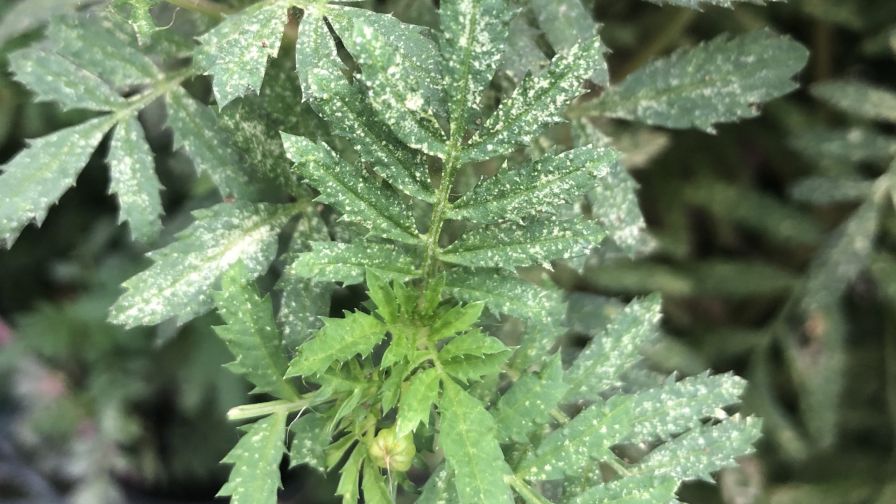Mite Management in the Greenhouse Requires Careful Planning

Typical damage of twospotted spider mites is stippling and chlorosis on the leaves. Photo: Juang Chong, Clemson University
Phytophagous or plant-feeding mites are among the most common pests in ornamental plant production. Correct identification of mite species or life stages is critical to mite management, as many biological control agents and miticides target specific mite species and life stages.
Mites are extremely difficult to detect because they are small and prefer to hide on the underside or protected areas of leaves, shoots, buds, fruits, and bulbs. Mite populations grow very quickly because they have a short developmental time and high fecundity, and they can reproduce without mating when males are not available. They are also difficult to manage because of their high propensity to develop pesticide resistance.
Mites can be introduced into nurseries, greenhouses, and landscapes through infested cuttings, liners, bulbs, or finished plants. They also can disperse from nearby infested weeds and crops by walking or being carried in the wind or on an animal.
Successful mite management requires an integrated approach. A crop can be started clean by maintaining a weed-free growing area, quarantining incoming plant materials, and, when necessary, treating the incoming plant materials before moving them into the growing areas. When executed properly, preventive mite management using predatory mites and other biological control agents can be very successful in nurseries and greenhouses. Miticides are often required when curative treatment is needed to stop a mite population from doing further damage. An integrated pest management program that incorporates biological and chemical control tools will require careful consideration of the compatibility between biological control agents and pesticides.
- Members of the spider mite family are characterized by their ability to spin silk webs. Among them, the twospotted spider mite (Tetranychus urticae) is a major pest of a wide variety of ornamental plants. The twospotted spider mite is considered a warm-season mite because its population growth and damage are particularly severe during the warmer months of summer. Twospotted spider mites are highly variable in color but frequently have a dark spot on each side of the body.
- The tarsonemid mite family derives its common name from two long thread-like hairs on the last pair of legs of adult females. Cyclamen mite (Phytonemus pallidus) and broad mite (Polyphagotarsonemus latus) are the most notorious members of this family. One way to tell them apart is that cyclamen mite eggs are elliptical and smooth, whereas broad mite eggs are elliptical and covered with tiny whitish bumps that make them look like tiny footballs. The football-like appearance of the broad mite eggs also helps distinguish this mite species from spider mites and other pests that may cause distortion to the growing terminals (such as thrips).
- Eriophyid mites are microscopic, with two pairs of legs and elongated bodies, which give them an appearance of a banana or cigar. Eriophyidae is a large and diverse family with members often identified based on the damage they caused, such as blister, gall, bud, rust, stunt, and rosette. Compared with other mite groups, eriophyid mites are relatively host-specific, meaning that one species usually feeds on only one host plant species.
- Unlike the ‘true’ spider mites (Tetranychidae), false spider mites do not produce silk and are generally smaller and occasional pests of ornamental plants. False spider mites are usually flattened, which gives them the other common name—flat mites. Various Brevipalpus species are known to attack ornamental plants, including obovatus on privet and B. phoenicis on date palms in Florida. Red palm mite (Raoiella indica) is a pest of ornamental and fruit-producing palms in Florida. Phalaenopsis mite (Tenuipalpus pacificus) can cause significant damage to orchids in Florida greenhouses.
- Bulb mites are traditionally pests of bulbs and corms; however, reports of bulb mites damaging cuttings and liners in tissue culture or propagation have increased in recent years. Infestations of bulb mites can be difficult to detect initially because the mites are often concealed under bulb scales and skins. Damage by bulb mites is often not apparent until the population has reached a very high density and decay has occurred.
For more information on each family of mites, as well as mite management advice, click here to read an in-depth article from Dr. Juang Chong at Clemson University.









